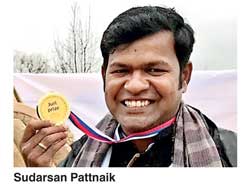Friday Nov 28, 2025
Friday Nov 28, 2025
Thursday, 18 May 2017 00:00 - - {{hitsCtrl.values.hits}}
By P.K. Balachandran
The exceptionally soft and fine sand on the beach at Puri in Eastern India has taken an Indian sculptor to great heights in the world of art.
Intrigued? Read this story on Sudarsan Pattnaik. Like all kids, Sudarsan began building small sand castles on the Puri beach in Odisha in Eastern India at the age of eight. 32 years later, in 2017, he finds himself in the Guinness Book of Records for building the world’s tallest sand castle measuring 48 feet and 8 inches (14.84 meters) at the same venue, the Puri beach.
Sudarsan is currently in the Sri Lankan capital showing his 40 ft long reclining Buddha at the Indian pavilion in the International Vesak Exhibition. 
While others love to trample on beach sand, Sudarsan has a different kind of love affair with it. He works on it to sculpt images and structures which have got him international recognition and a Padma Sri, India’s national award.
“Sand is my life and dream,” the 40 year old pioneer of sand sculpting in India said as Sri Lankans thronged to see his reclining Buddha.
Even as a child, Sundarsan’s creations on the Puri beach had won accolades from passers-by, tourists and pilgrims visiting the ancient Jagannath temple. They would stop to watch him work on wet sand, pat him on the back and utter encouraging words.
But his life on the beach hid a sad story. Being from a broken family, with only the mother and his grandmother to look after him and his three siblings, Sudarsan had to become a child laborer to keep the home fire burning.
“I had to stop with Grade 6 and take work as a domestic in another house. In my spare time, I would go to the beach and build sand castles, which to my astonishment, got appreciation, when domestic work, which was much harder, got no appreciation at all!” Sudarsan recalled.
Appreciation from foreign tourists proved to be particularly important as it was the forerunner of the international recognition he gained later in life. The encouragement he got from visitors to the beach made him experiment with the art and the material he used.
He gathered a lot of information on various types of sand and how they could be compacted and used for sculpting finely chiselled images which would also last for a reasonable period of time. Sand sculptures can last anywhere from a week to a month depending on the weather, the type of sand used, and the quality of sand compacting.
Sudarsan also experimented with themes boldly. While most traditional sculptors or image makers stuck to the tried and tested themes like Hindu gods and goddesses, Sudarsan chose socially and politically relevant themes. As he progressed, the themes took on a national and international flavour.
Well-timed sculptures on national and international themes done in a public place like the Puri beach, attracted media attention both locally and internationally. International news agency photographers converged on the Puri beach to click his works. His sand sculptures got wide play in the media across the globe.
Sudarsan Pattnaik and his sand icons soon became internationally known. Invitations to participate in international competitions poured in.
“In fact, I was in Moscow before coming to Colombo and I had won a gold medal there,” Sudarsan said.
Keen on making sand sculpture a people’s movement, Sudarsan is happy that many of his awards are “Peoples’ Choice” awards based on voting by viewers at exhibitions.
A campaigner for peace and harmony in India and the world, Sudarsan’s themes are meant to convey socially and politically useful messages.
“I have sculpted images to urge people to preserve the environment, eschew violence and respect women. I have done a sculpture urging India and Pakistan to settle their disputes peacefully and titled it: ‘Bullets can’t bring permanent peace.’ In fact have done several sculptures calling for India-Pakistan understanding,” he said.
Sudarsan has sculpted leading personalities like Nelson Mandela, Mother Teresa and Benazir Bhutto as his tribute to them. He has marked historically significant events like Barack Obama getting the Nobel Peace Prize. He even sculpted Donald Trump when he was elected US President after a controversy-ridden campaign.
“But I am not a political person,” Sudarsan insists. “My interest is in the promotion of peace, a good environment, social harmony and good health. I do not undertake political sculpting for money,” he said. For a man from a small town with education only up to Grade 6, Sudarsan Pattnaik speaks good English.
“I picked it up by interacting with Western tourists on the Puri beach and honing it during his interactions at international conferences,” he said.
Sand sculpture is an accepted art form in several countries, particularly the US, Russia, and Germany.
“I have visited more than 50 countries at the invitation of organisations to exhibit my work,” Pattnaik said.
He is India’s first sand sculptor and is perhaps the only known one from South Asia. The art form pioneered by him is widely appreciated but is yet to secure adherents and practitioner in significant numbers.
To rectify this flaw, Sudarsan has set up a school in his native Puri.
“The school is on the beach, in the open. Five of my students have come with me to Colombo to build the statue of the reclining Buddha. I have had students from Sri Lanka too,” he said, confident that sand sculpting will live on in India.
Asked if he would ever leave or diversify from sand sculpting to take to stone as a medium, Sudarsan’s answer was a firm “no”.
And he has a philosophical, perhaps a Buddhist, rationale for sticking to sand: “Sand sculpture, which lasts a week or so, shows the impermanence of things in life. Life is change and we have to be doing new things every now and then.”